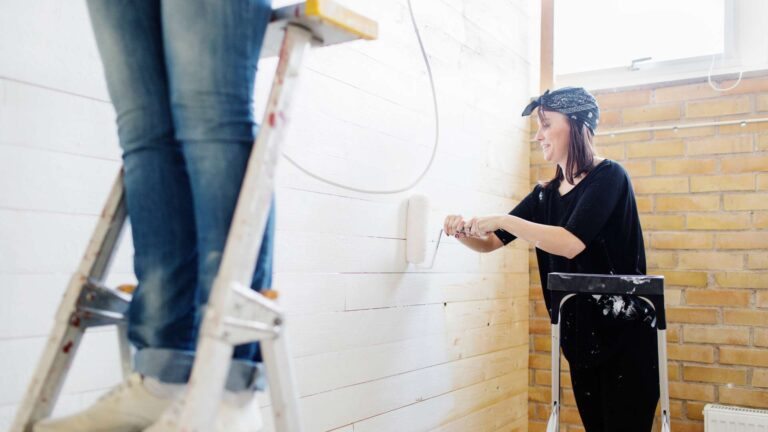Table of Contents
As home renovation costs continue to rise, homeowners seek smarter and safer ways to prepare financially. From small upgrades to full-scale remodels, having a reliable pool of savings is essential. That’s why more homeowners turn to high-yield savings accounts (HYSAs).
These accounts offer better interest rates than traditional savings while maintaining the flexibility needed for renovation timelines. That brings us to the question: Can you use a HYSA to save for home renovations? Read on to learn how to plan and fund home renovations without sacrificing liquidity or risking your capital in volatile markets.
Why HYSAs Are a Smart Fit for Renovation Goals
A HYSA gives you the best of both worlds: safety and steady growth.
- Better interest rates: Most HYSAs earn 10–20x more interest than regular savings accounts.
- Full liquidity: Your money isn’t locked up, unlike CDs or brokerage investments.
- No market risk: Unlike stocks, HYSA balances don’t fluctuate, which is important when timing significant expenses.
If your home upgrade timeline spans 3 to 18 months, a HYSA is ideal—it lets you plan confidently while your money earns along the way.
What Types of Renovations Are Best Suited for HYSA Savings?
Not all renovations are created equal. Some are perfect for HYSA-based funding because they’re planned, short-term, and moderately priced.
Here are a few examples:
- Bathroom and kitchen remodels: These standard upgrades often have predictable timelines and phased costs.
- Roofing or insulation replacements: Projects that require flexible scheduling but benefit from upfront payment.
- Appliance upgrades or energy-efficiency installations: Like HVAC replacements or solar panels—sizable but not urgent.
- Cosmetic changes: Flooring, repainting, cabinetry, or lighting improvements that can be spaced out.
These are generally well-suited to a 3–12 month savings strategy using a HYSA.
How to Build a Renovation Savings Plan Using an HYSA
Creating a renovation fund in a HYSA requires a simple but strategic approach:
- Estimate your renovation costs: Break the project into line items, such as materials, labor, permits, design fees, etc.
- Set your savings timeline: Decide when to start your renovation and back-calculate how much you need to save monthly.
- Automate your contributions: Set up recurring transfers from your checking account to your HYSA. Consistency matters more than amount.
- Track your interest earnings: HYSA interest can help speed up your savings timeline. Many banks display estimated monthly growth, which you can use to adjust your plan as needed.
This method lets you stay organized, disciplined, and financially stress-free.
Comparing HYSAs to Other Ways of Saving for Renovations
| Method | Liquidity | Risk | Earnings Potential | Best For |
| HYSA | High | None | Moderate | Flexible savings, 3–18 month plans |
| CD (Certificate) | Low | None | Slightly Higher | Fixed-timeline goals, no urgency |
| Brokerage Account | Medium | High | High | Long-term renovation planning |
| Home Equity Loan | High | Medium | Varies | Immediate renovations, high budget |
HYSAs are best when you need a safe, short-term place to grow your funds. A HELOC might be better for immediate large projects.
Top HYSA Picks for Home Renovation Savers
Not all HYSAs are created equal. These providers stand out for ease of use, good APYs, and homeowner-friendly features:
- Ally Bank: Known for its intuitive interface, automatic savings tools, and strong mobile experience.
- Marcus by Goldman Sachs: Offers a highly competitive APY and no fees.
- Synchrony Bank: Provides optional ATM access, helpful for renovation-related spending.
- Capital One 360 Performance Savings: Great for seamless transfers from checking, with no monthly fees.
- American Express® Personal Savings: High APY with a reputation for reliability and easy external linking.
Each is FDIC-insured, offers no monthly fees, and supports automated transfers—key features when building a renovation fund.
Mistakes to Avoid When Using a HYSA for Renovations
Even intelligent savers make mistakes. Avoid these common pitfalls:
- Underestimating total project costs: Always add 10–20% for unexpected issues.
- Withdrawing funds too often: Some HYSAs have withdrawal limits that reduce your interest potential.
- Saving in checking instead: Low or no interest, and an easier spending temptation.
- Ignoring contractor payment terms: If a deposit is due quickly, ensure you can transfer funds quickly.
Being prepared is half the battle—plan to maximize growth and flexibility.

How to Withdraw and Use HYSA Funds for Renovation Expenses
Getting your money out when needed is just as important as saving it.
Here’s how to do it right:
- Plan phased withdrawals: Match transfers to project milestones, such as contractor deposits, material delivery, or final payments.
- Link to your checking account: Most HYSAs allow 1–3 day transfers. Some even support same-day moves.
- Monitor APY updates: If your HYSA adjusts rates monthly, try timing large draws after interest posts.
This ensures you aren’t interrupting your compounding interest unnecessarily.
When Not to Use a HYSA for Home Renovation Goals
While HYSAs are flexible, they’re not ideal for every renovation scenario. You may want to explore other options if:
- You need a large sum immediately: Consider a HELOC or personal loan instead.
- Your timeline exceeds two years: A brokerage account or CD ladder may offer better returns.
- Your contractor only accepts credit cards: Some HYSAs don’t offer debit card or direct payment options—make sure yours does.
Think about how quickly you’ll need the funds and how long you can let them grow before committing.
Conclusion
Using a HYSA to save for home renovations is a savvy financial move, especially if you’re planning upgrades within a year or two. It helps you stay debt-free, earn safe interest, maintain flexibility, and peace of mind. With the right HYSA provider, an automated savings plan, and clear renovation goals, you can tackle your dream project without dipping into retirement funds or relying on high-interest debt.
Whether you choose an online bank or a neobank like Beem, choose a HYSA that fits how you live, save, and manage your money. Download Beem today to open your HYSA, track interest in real time, and connect your savings to smarter money habits. In addition, Beem’s Everdraft™ lets you withdraw up to $1,000 instantly and with no checks.
FAQs About Can You Use a HYSA to Save for Home Renovations
Can I use my HYSA money directly for renovation payments?
Yes, but most HYSAs don’t allow direct payments to vendors or contractors. You’ll usually need to transfer the money to a linked checking account first. This step adds a slight delay, typically 1–3 business days, so plan for large payments or scheduled milestones in your renovation project.
Is a HYSA better than a credit card or loan for home projects?
If you’ve already saved for your project, using a HYSA is often smarter than taking on debt. It allows you to avoid interest charges, maintain control of your spending, and grow your savings through high APY. However, financing might still be needed for large or urgent renovations.
How much should I save for a typical home renovation?
The cost varies widely based on the project. Kitchen renovations can cost anywhere from $10,000 to $50,000, depending on materials and layout changes. Smaller updates, like painting or flooring, range from $2,000 to $5,000. Having a target budget helps set realistic HYSA savings goals.
Can I earn interest on my renovation fund with an HYSA?
Yes. That’s the primary advantage of using a HYSA. While your renovation funds sit untouched, they continue to earn interest, often 4.00% APY or higher. This means you’re maximizing the value of money you plan to spend anyway, making your savings more productive during the planning phase.
Do HYSAs have withdrawal limits that affect renovation payments?
Some HYSAs used to enforce a six-withdrawal-per-month limit due to federal rules, but many restrictions have been eased post-pandemic. Still, certain banks may apply fees or limits after multiple withdrawals. Always check your HYSA’s terms before making frequent payments during renovations.
Is it safe to keep large renovation funds in a HYSA?
Yes, as long as your account is with an FDIC-insured bank or NCUA-insured credit union. Your funds are protected up to $250,000 per depositor, per institution. For most homeowners, this is enough coverage for even large renovation budgets stored safely in one HYSA.
How fast can I access HYSA funds for my contractor?
Transfers from a HYSA to a linked checking account typically take 1–3 business days. Some banks offer same-day or even instant transfers if your checking account is with the same institution. Be sure to account for this delay when coordinating payments with contractors or vendors.
Can I automate renovation savings into my HYSA?
Yes. Most HYSA providers support automatic transfers from a checking account. You can set weekly, biweekly, or monthly contributions toward your renovation goal. Automating the process makes it easier to stay disciplined and ensures your renovation fund grows steadily over time without manual effort.
Will HYSA savings affect my taxes if used for home improvement?
The money you withdraw from your HYSA isn’t taxed, but the interest you earn is taxable. HYSA funds for home renovations won’t create any direct tax penalties. However, major renovations may increase your home’s cost basis, which can affect capital gains taxes later.
Can I use multiple HYSAs for different renovation phases?
Absolutely. Some banks even offer bucket-style features within a single HYSA, letting you label funds as “kitchen remodel,” “landscaping,” or “bathroom update.” Alternatively, you can open separate HYSAs to manage and track your progress across phases. Just ensure you’re maximizing APY and avoiding unnecessary account fees.
















































